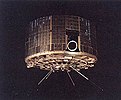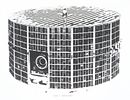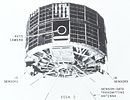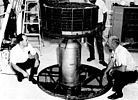Television Infrared Observation Satellite
Television Infrared Observation Satellite or TIROS, (in Spanish, Satélite de Observación por Televisión e Infrared) is a series of the first meteorological satellites launched by the United States, beginning with the launch of TIROS-1 in 1960. TIROS was the first satellite that was capable of remote sensing the Earth, allowing scientists to see it in a new perspective from space.
The program, launched by Harry Wexler, demonstrated the utility of satellite weather observation, while military reconnaissance satellites were secretly developed. TIROS demonstrated at that time that the key to success is often simplicity
Features
The 270lb satellite was launched into a nearly circular low-Earth orbit by a Thor Able missile. Drum-shaped, with a diameter of 42 inches and a height of 19 inches, the TIROS satellite carried two six-inch television cameras. One of the cameras had a wide-angle lens with an f/1.6 (aperture), which could observe an 800-mile swath of Earth at a time. The second camera had a telephoto lens with an f/1.8, with a power increase of 10 to 12 over a wide-angle camera.
The satellite itself was stabilized in its orbit by spinning like a gyroscope. When it was separated from the rockets it was spinning at about 136 rpm. To avoid motion blur photography, a spin mechanism slowed the satellite down to 12 rpm and then brought it into orbit.
The camera shutters made possible a series of still images that were stored and transmitted to Earth via 2-watt FM transmitters as soon as the satellite approached one of its ground command points. After transmission, the tape was erased and prepared for further recording.
TIROS continued as the ESSA TIROS Operating System and was eventually succeeded by the NOAA ITOS (TIROS Enhancement Operating System), or TIROS-M, and later by the TIROS-N and TIROS-N Advanced series of satellites.
The names of the satellites can be confusing because the satellites share the same organization name in their content.
The participants in the satellite project are the following:
 National Aeronautics and Space Administration.
National Aeronautics and Space Administration. United States Army Signal Corps.
United States Army Signal Corps. National Meteorological Service.
National Meteorological Service. National Intelligence-Geospatial Agency.
National Intelligence-Geospatial Agency.- ↓ Radio Corporation of America.
Series
SHOTS
SHOOT Operational System
| Name | T. | Image | Image |
|---|---|---|---|
| ESSA-1 | (OT-3) |  |  |
| ESSA-2 | (OT-2) |  |  |
| ESSA-3 | (TOS-A) |  | |
| ESSA-4 | (TOS-B) |  | |
| ESSA-5 | (TOS-C) |  | |
| ESSA-6 | (TOS-D) |  | |
| ESSA-7 | (TOS-E) |  | |
| ESSA-8 | (TOS-F) |  | |
| ESSA-9 | (TOS-G) |  |
ITOS/SHOTS-M
SHOTS-N
| Name | T. | Launch | Image | Image |
|---|---|---|---|---|
| TIROS-N | 13 October 1978 |  | ||
| NOAA-6 | (A) | 27 June 1979 |  | |
| NOAA-B | (ITOS-1) | 29 May 1980 |  | |
| NOAA-7 | (C) | 23 June 1981 |  |
Advanced TIROS-N
Contenido relacionado
Humanities
Panthropy
Academic discipline




























